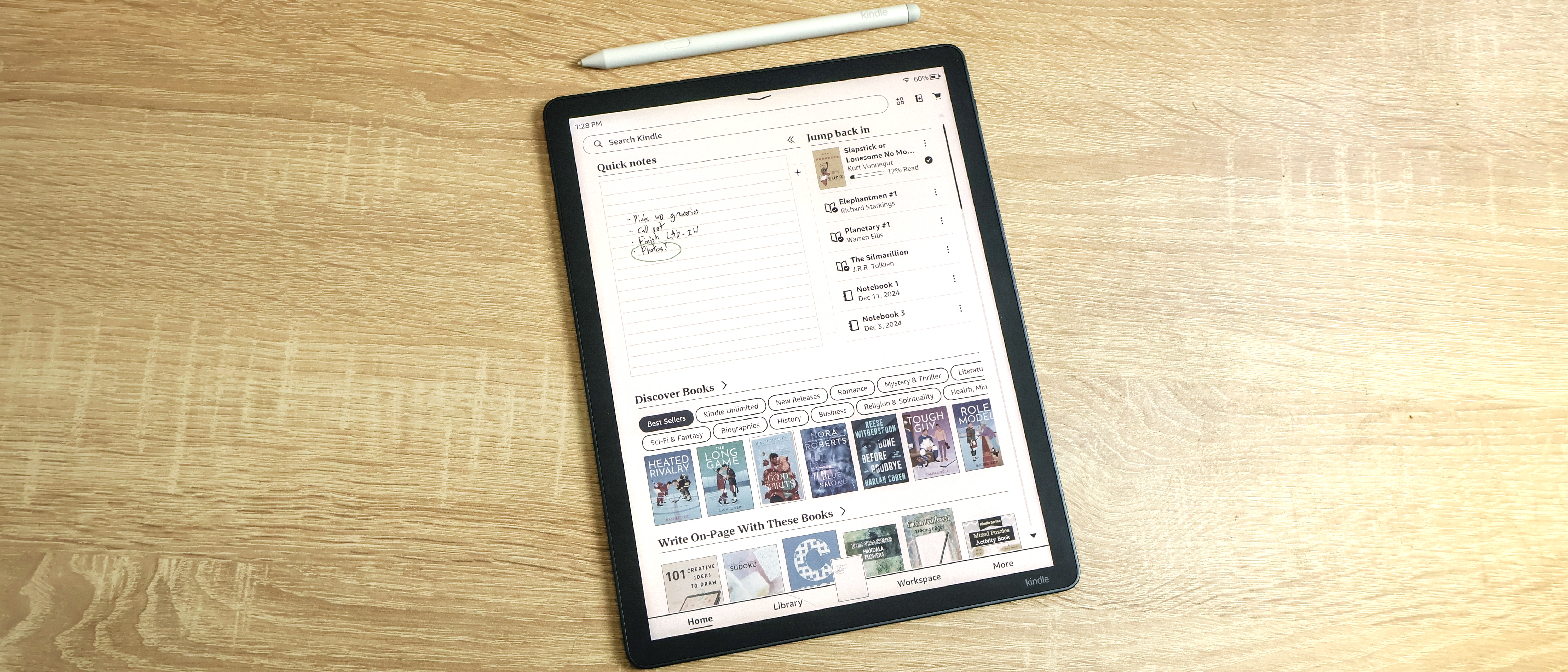9 of the best quad exercises to fire up your glutes
Get the most bang for your buck on leg day with these compound movements
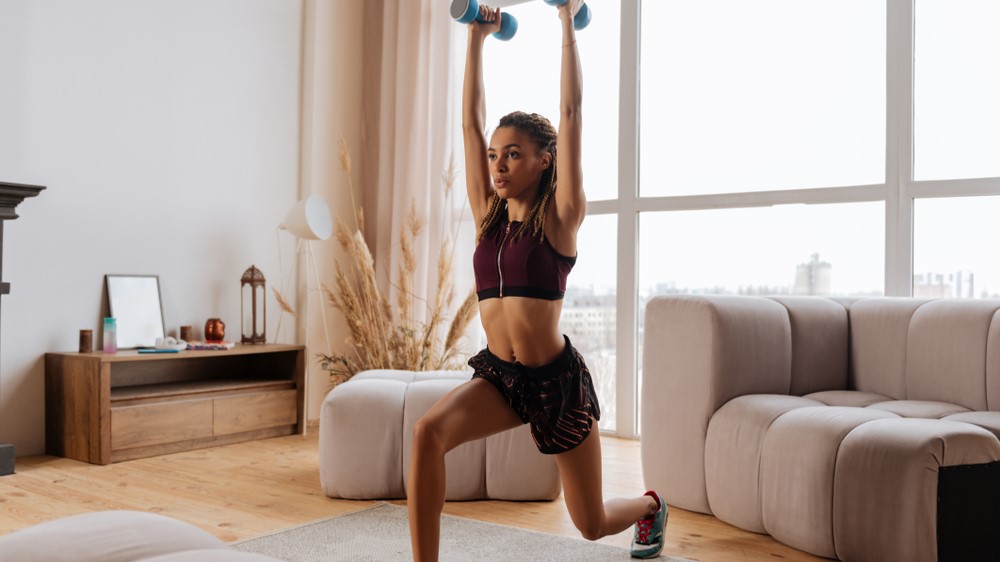
Leg day: some fitness enthusiasts live for it, while others would rather focus on “the gun show” (or upper body, for the uninitiated). Whatever your preference though, strengthening your lower body — especially your quads and glutes — is essential for maintaining a healthy and injury-free body.
Your legs and hips are responsible for a lot of movements — walking, climbing stairs, sitting down, and standing up all require power and stability from the lower body. If you’re running to catch a train or bending over to pick up one of your kids, you’ll need strong and conditioned quadriceps and glutes to get the job done.
The best way to achieve that strength and conditioning is through progressive resistance training, performing specific exercises for a number of repetitions, and then increasing the resistance when the exercises start to feel easier. Resistance can come from many different sources like the best adjustable dumbbells, barbells, weight machines, the best resistance bands, and even your own body (a good option if you’re just beginning to work out regularly).
Try 9 of the best quad exercises to fire up your glutes. You’ll target both of these important muscle groups while building an overall strong and toned lower body!
What muscles make up your quads and glutes?
The quadriceps femoris is an aptly-named group of four different muscles located at the top and the front portion of your thigh: the rectus femoris, vastus lateralis, vastus medialis, and vastus intermedius, all attaching at the same tendon right above the knee. The quadriceps femoris extends the knee and flexes the hip, allowing you to perform actions like walking, running, kicking, and jumping. It’s one of the largest muscles in your body.
Another large muscle in your body is the gluteus maximus, which, along with the gluteus minimus and gluteus medius, make up the glute complex. These muscles located in the back and sides of your hips keep your pelvis aligned and supported, propel your body forward when walking or running, and support your lower back and spine when lifting things off the ground.
Here are 9 of the best quad exercises to fire up your glutes:
1. Squat

The squat is the be-all and end-all of lower body exercises. Inherently functional and incredibly efficient, the squat will work your quads and glutes to great degrees (along with several other muscles below the belt).
Get instant access to breaking news, the hottest reviews, great deals and helpful tips.
To perform the squat, stand tall with your feet aligned shoulder-width apart. Lengthen your arms in front of you for balance, or cross them over your chest. Sending your hips behind you as if you were about to sit in a chair, bend your knees and lower your tailbone towards the floor. Sink as deep as you can, aiming to bring your hips at least parallel to your knees (or deeper, if your range of motion allows). Once you’ve gotten to the end of your range, squeeze your glutes, engage your core, and stand tall. Keep your body weight evenly distributed between both big toes, pinky toes, and heels throughout the exercise. Repeat for 10-12 repetitions, or until you feel muscle fatigue.
A common mistake made by beginners is to bend at the knees before setting the hips back, placing too much weight on the ball of the foot and allowing the heel to raise off the ground. If you’re just learning how to squat, avoid this pitfall by placing a box or chair behind you and tapping your hips onto the seat. You’ll also want to make sure your knees don’t cave in (referred to as a knee valgus) as you lower yourself down. Gently press your knees out, keeping them lined up with the center of your feet.
Depending on your anatomy, you may also need to turn your toes out slightly or choose a wider stance. Play around with what feels comfortable and natural - remember, you’ll want to feel the work being done in the muscles without any impingement in the knees or hips.
Once you’ve got the basic movement down, increase the difficulty by picking up some dumbbells or a barbell.
Here's more on how to do a squat, the most common mistakes to avoid, and the modifications to try.
2. Reverse lunges
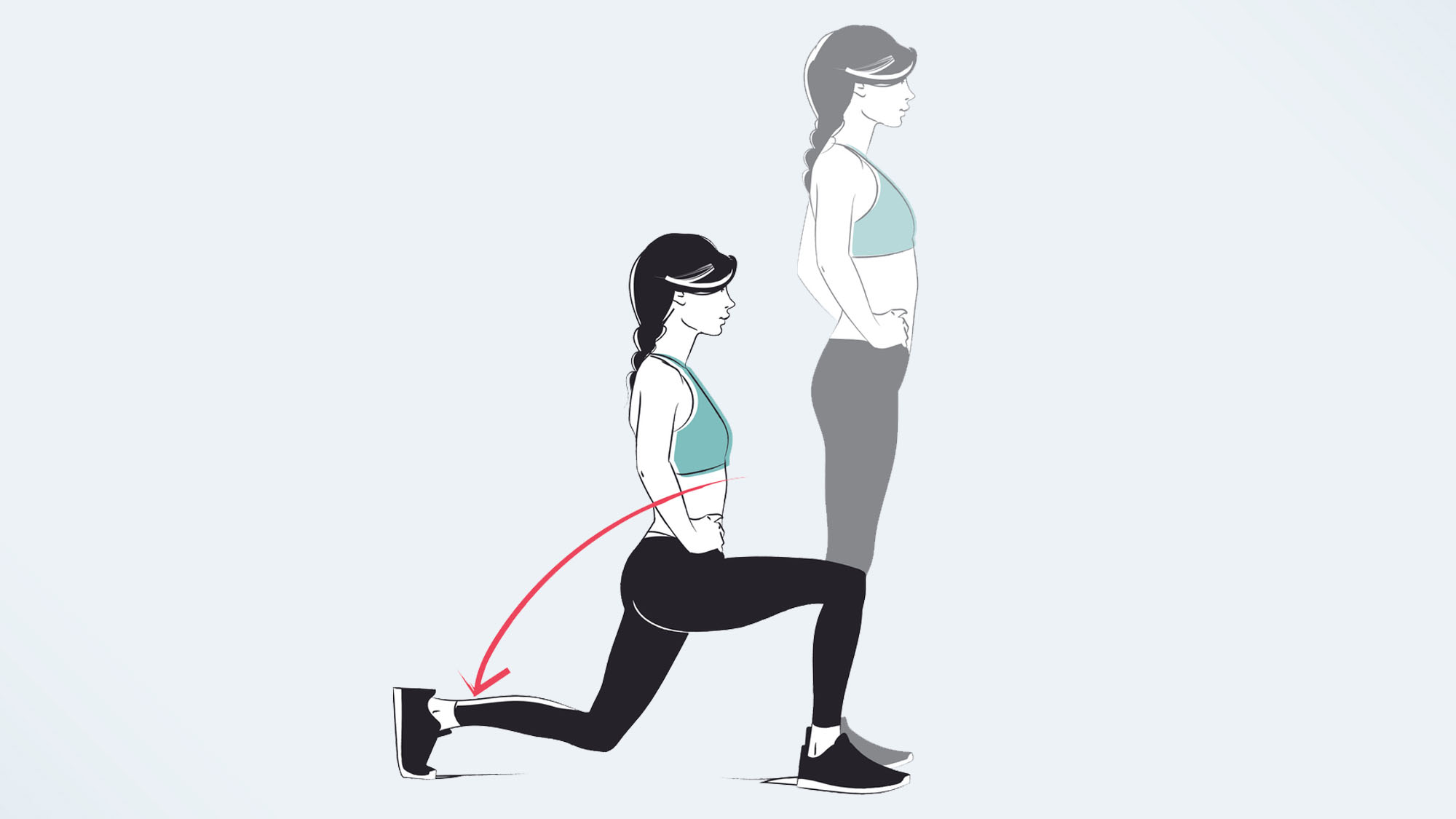
There are several lunge variations on this list, and for good reason: the unilateral (or one-sided) movement effectively targets each quad and glute muscle independently of the other, which allows you to address any strength or hypertrophy discrepancies between your left and right sides.
To perform a reverse lunge, stand tall with your feet aligned hip-width apart. Step one foot directly behind you, keeping your hips square to the wall in front of you. Bend your back knee and aim it towards the floor, letting your front knee bend to around a 90-degree angle as you lower yourself. Keep your front knee aligned with the center of your foot, and your front heel firmly planted. Once you’ve reached the end of your range, press through your front heel to stand tall again, and step forward with your back leg to the starting position. Repeat for 10-12 repetitions on one side, or until muscle failure. Follow with 10-12 repetitions on the other side.
If you find your front heel raising as you bend your knees, try stepping back further with your back foot. To target more of your glutes with the reverse lunge, pitch your torso forward slightly as you stand up from the bottom of your range. To target more of your quads, keep your torso upright.
Amp up the reverse lunge’s difficulty by adding weight through dumbbells, barbells, or kettlebells. You can also choose to alternate between your left and right sides, as opposed to completing a set on one side before moving to the other.
Here's more on how to do a lunge, plus what happened when our fitness editor did 100 lunges a day for a week.
3. Lateral lunges
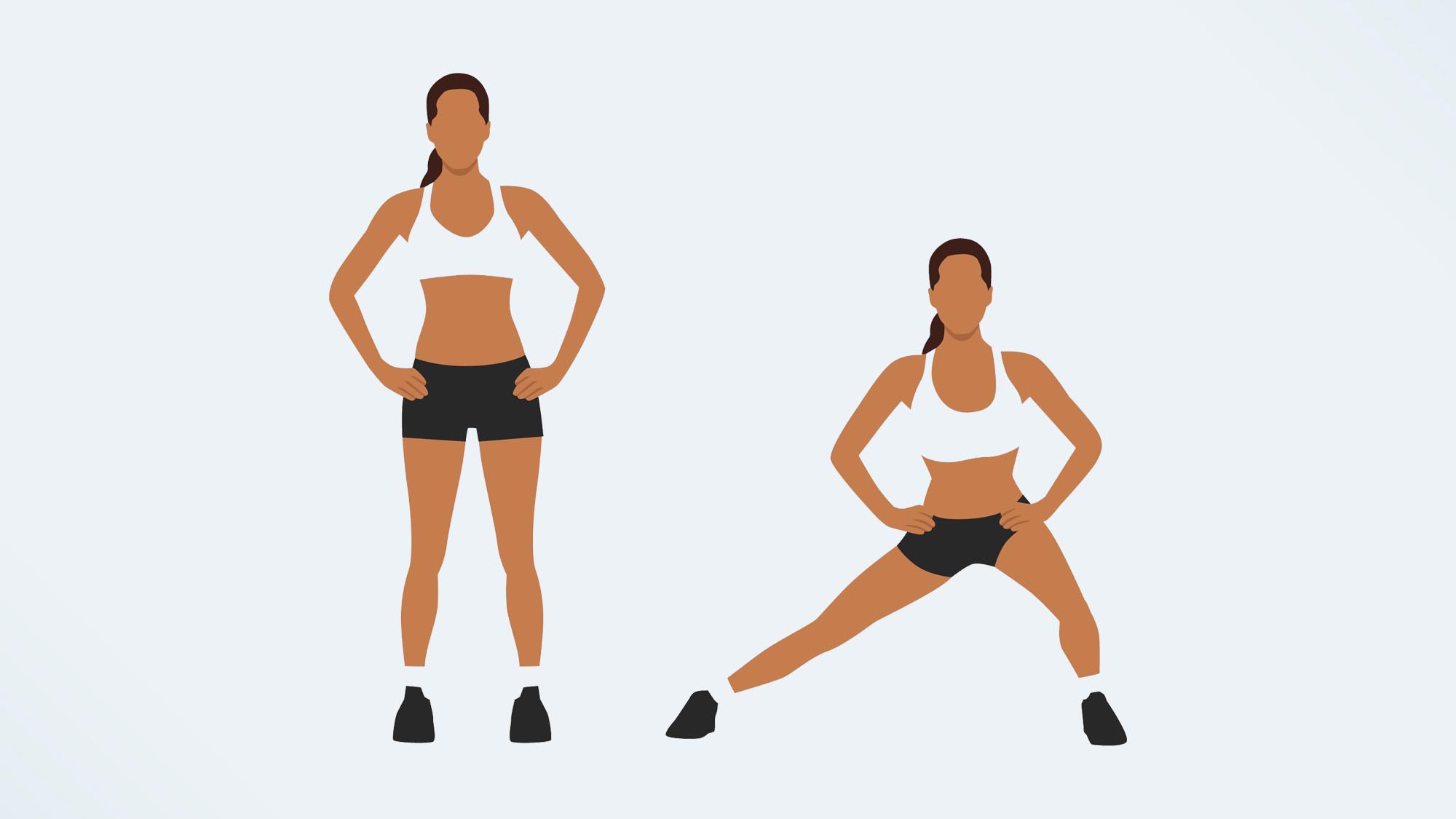
Our second lunge variation, the lateral lunge, will fire up your quads and glutes with the added bonus of hip adductor (or inner thigh) activation.
To perform the lateral lunge, stand tall with your feet about hip-width apart. Step widely to the side with your right foot. Keep your toes pointing directly in front of you. Set your hips back and bend your right knee, placing the majority of your body weight on the right foot while the left leg stays long. Pitch your torso forward slightly as you bend the knee, but keep your chest tall. Once you’ve reached the end of your range, press through your right foot and stand tall. Step your right foot back to the starting position. Repeat for 10-12 repetitions or until muscle failure, then perform on the left.
If you’re a beginner, you may notice that you can’t get a very deep range of motion in the lateral lunge. That’s okay — work with whatever range allows you to keep optimal form. As you build strength and mobility in the lower body, your range will improve.
Adding a dumbbell or two will make the lateral lunge more challenging. If you’ve mastered the form, try alternating between your left and right sides for a set of repetitions.
Here's what happened when this fitness writer did 30 lateral lunges every day for a week.
4. Pistol squat
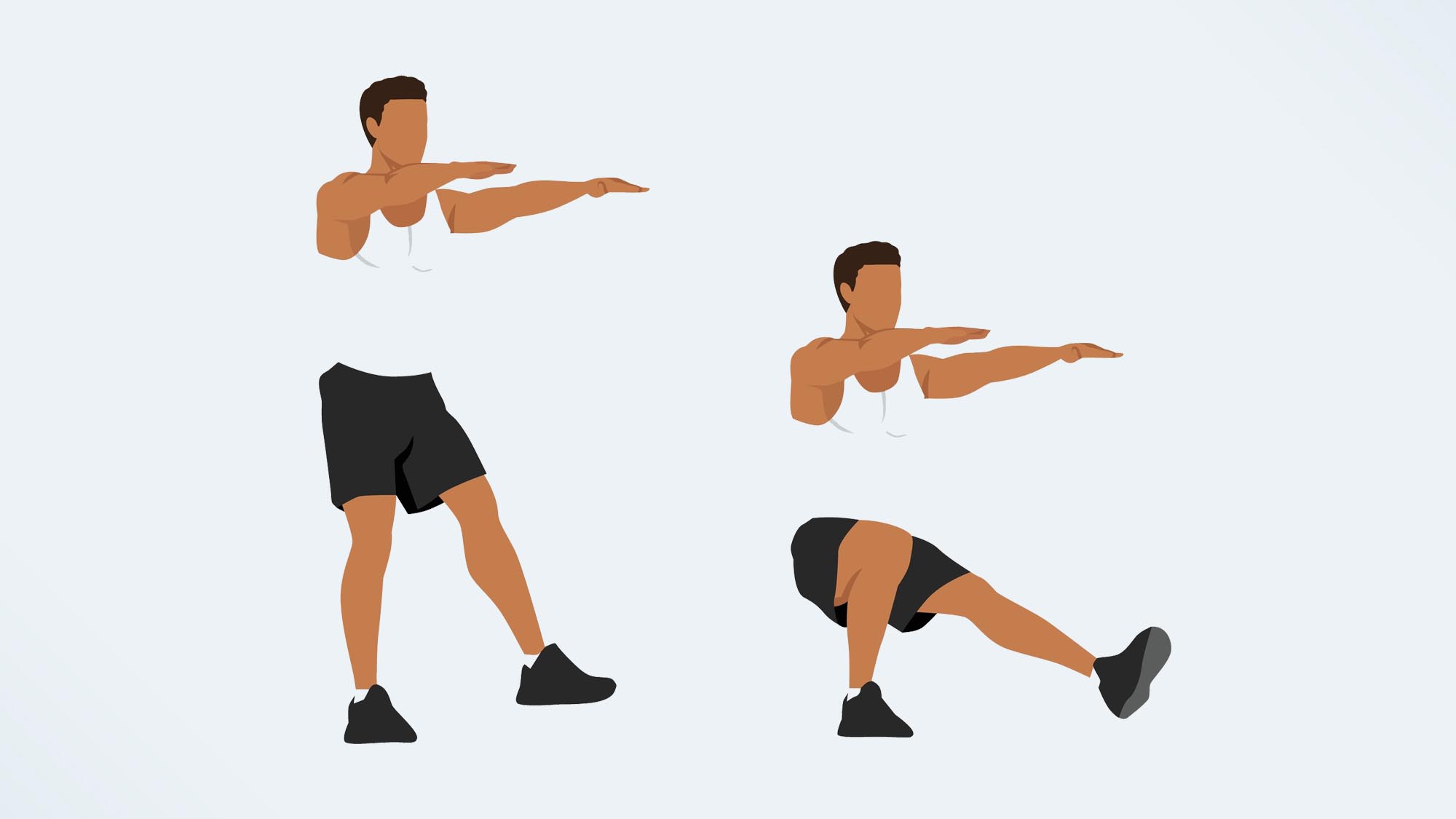
The pistol squat is an incredibly advanced exercise requiring a lot of strength and mobility in your hips, legs, and ankles. Fortunately, there are ways to modify the pistol squat as you progress in your routine.
The standard pistol squat is performed by standing with your feet together, lined up underneath your hips. Extend your left leg in front of you (completely straight, if possible) and balance on your right foot. Extend your arms in front of you for counterbalance. Set your hips back and bend your right knee, lowering your hips toward the floor and staying balanced on your right foot. Keep the chest tall and back neutral. Once you’ve reached the end of your range, press through the right foot and stand up, returning to the starting position. Repeat for a set of 10 repetitions or until muscle failure, then follow with 10 repetitions on the left leg.
Very few beginners will be able to do a pistol squat in a full range of motion correctly, but there are more accessible ways to get the benefits of the exercise. One of these ways is to grab a chair or a bench and place it behind you. Balance on your right foot, set your hips back behind you, and sit down. Stand back up, staying balanced on your right foot. If balance is an issue, place your left toe on the ground for stability, but keep the majority of your body weight on your right foot. Complete 10 repetitions, then repeat on the left side.
Progress the pistol squat’s difficulty by holding onto dumbbells or kettlebells as you work through the repetitions.
5. Bulgarian split squat
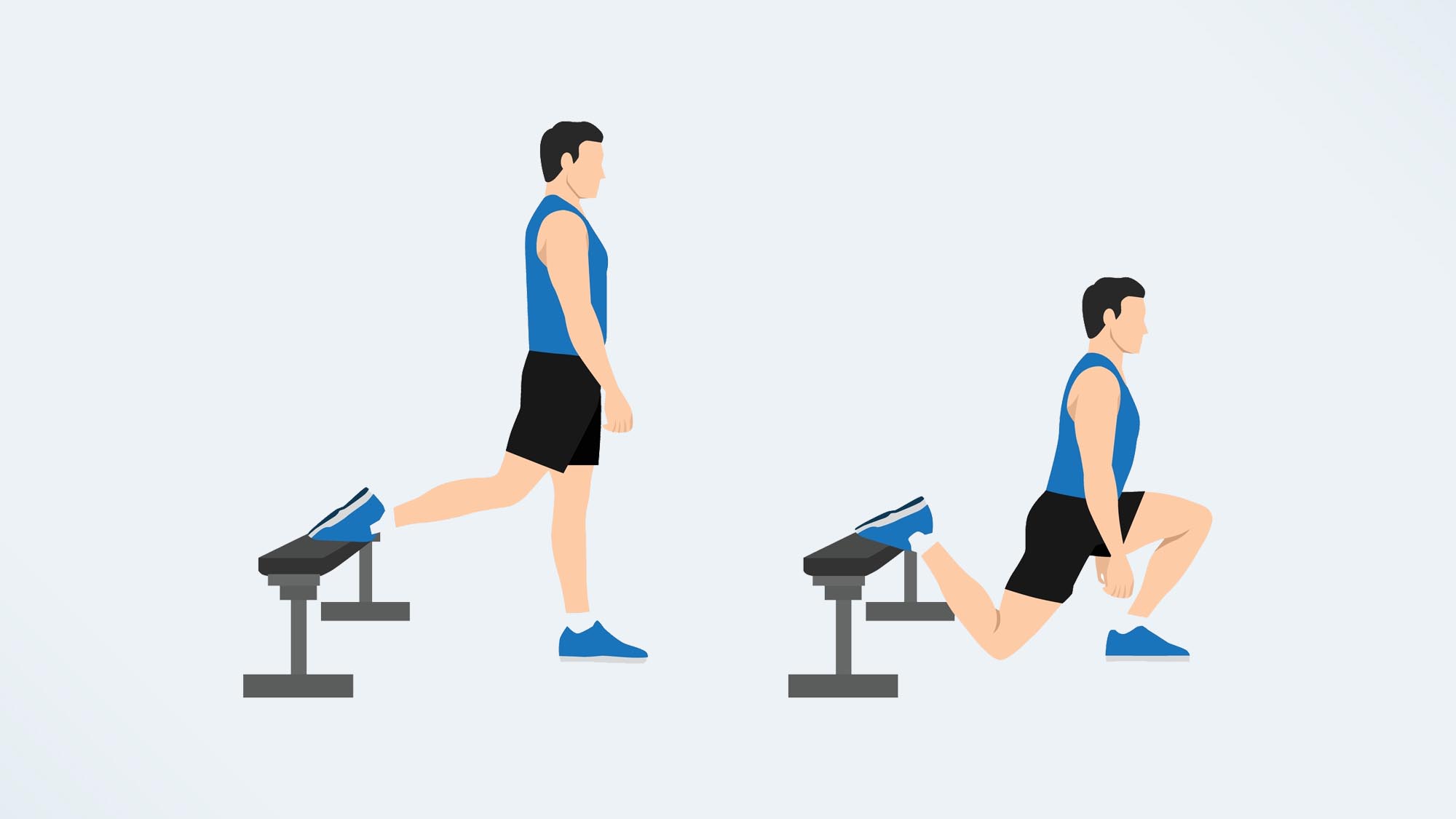
The set up for a Bulgarian split squat can be somewhat tricky (take a look at this video for a helpful tip), but if done correctly, it can target both your quads and glutes effectively.
To perform the Bulgarian split squat, place a chair or bench behind you and stand with your feet about hip-width apart. Step your left foot behind you, placing it on top of the chair or bench. Set your hips back and pitch your torso forward slightly. Bend your right knee and lower your hips, aiming your left knee towards the floor. Once you’ve reached the end of your range, press through the right foot to stand tall. Repeat for 10 repetitions, then perform 10 repetitions on the left side.
If your hip flexors are excessively tight, getting into the starting position may pose a challenge. To modify the Bulgarian split squat, remove the chair or bench and step one foot behind you, keeping it on the floor.
If you’re up for a bigger challenge, hold onto dumbbells or kettlebells as you perform the exercise.
Read more about how to do a Bulgarian split squat here, plus, what happened when our fitness editor did 50 Bulgarian split squats a day for a week.
6. Step ups
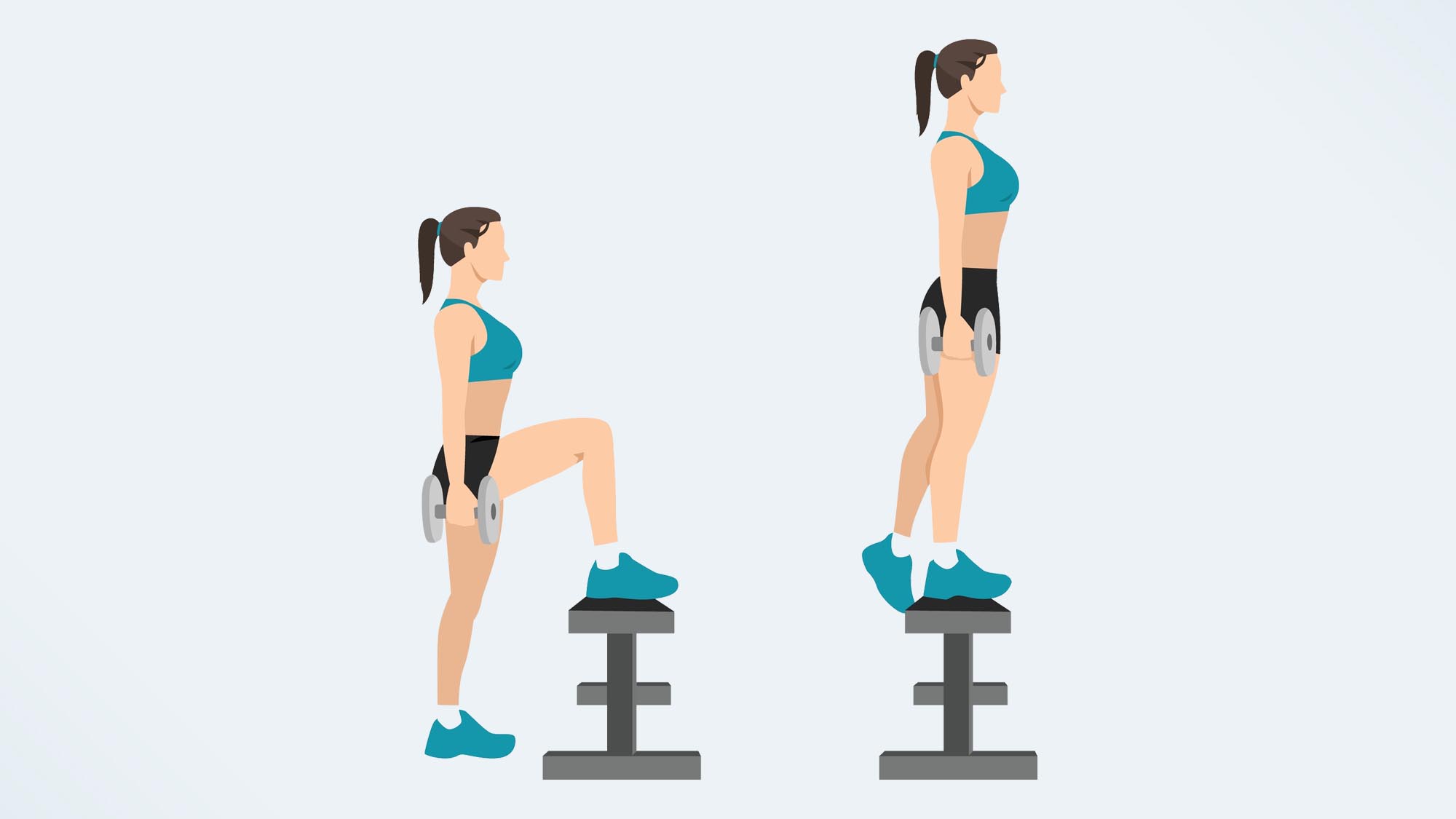
If you have to climb stairs at any point during your day, you’re already familiar with the Step up — a great functional exercise to add to your lower body routine.
To perform the Step up, place a box or bench in front of you. Place your right foot on top of the box or bench, making sure your entire foot is on the platform - don’t allow your heel to hang off of the side. Pressing into your right foot and pitching forward slightly, step up onto the platform and place your left foot next to your right. Engage your core, step your left foot back behind you, and slowly lower your left foot back onto the floor while keeping your right foot on the platform. Repeat for 10 repetitions, then switch to the left side.
Depending on the height of your platform, Step ups can either target more of your quads or more of your glutes. A shorter box or bench will work your quads, while a taller box or bench will put the focus on your glutes. If you’re just beginning to exercise regularly, start with a lower step to build balance and stability.
To add a challenge to the step-up, pick up a dumbbell or kettlebell and hold it as you perform the exercise. Here's more on how to do a weighted step-up.
7. Sumo deadlift
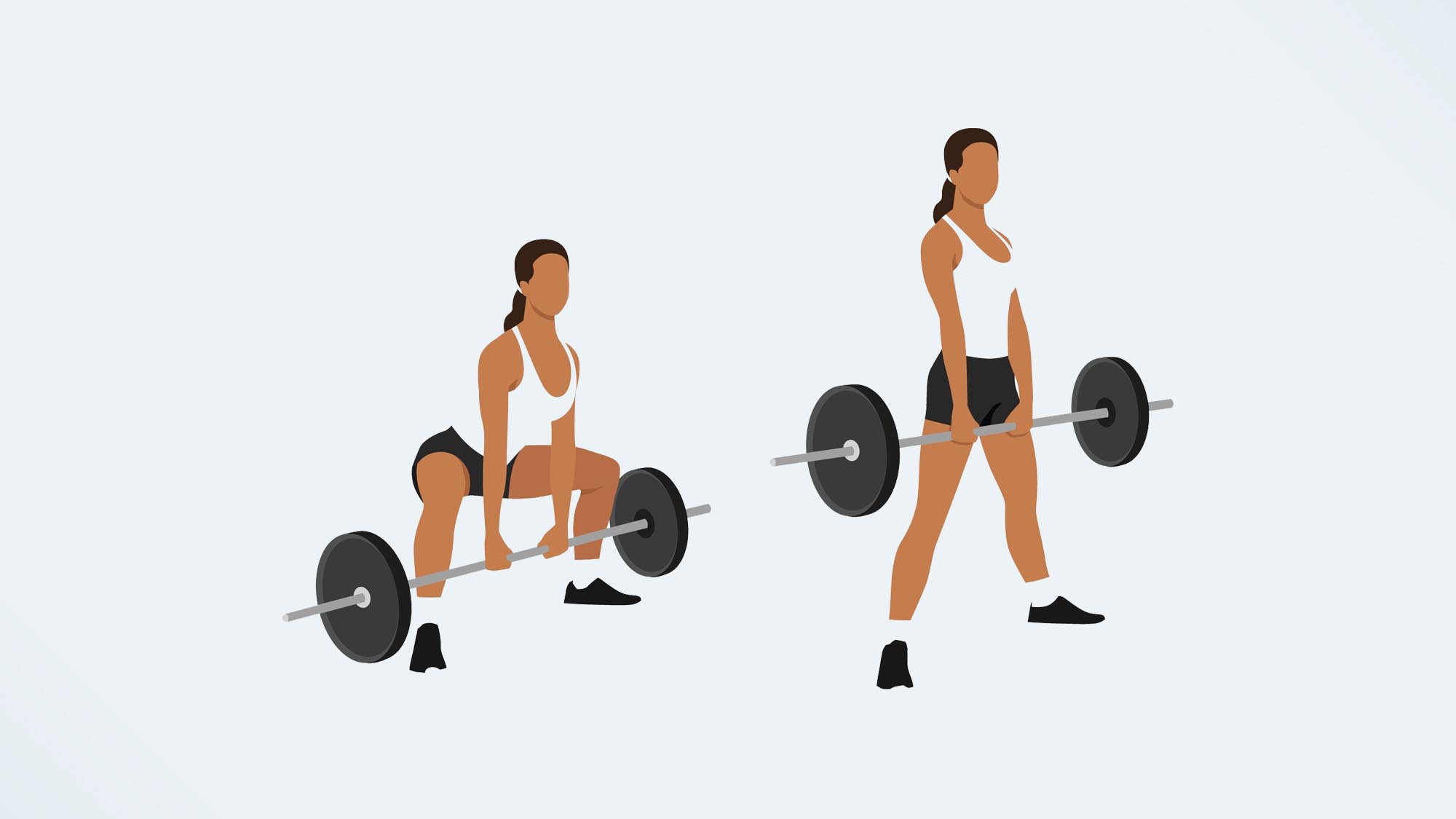
Conventional deadlifts will mostly activate the hamstrings, glutes, and lower back, but changing your stance and set-up to a Sumo deadlift will bring the quads into the mix as well.
To perform the Sumo deadlift, place two heavy dumbbells or a moderately heavy barbell on the floor in front of you. Stand with your feet slightly wider than shoulder-width apart, and your toes pointed out at around a 30-degree angle. Set your hips back behind you, keeping your core braced and your back engaged. Grab the dumbbells or barbell with your hands about shoulder-width apart. Drive your hips forward to stand tall, picking the dumbbells or barbells off of the floor. Slowly set your hips back and lower the weight back down to the floor. Repeat for a set of 10-12 repetitions, or until you reach muscle fatigue.
If you’ve never tried the Sumo deadlift, try practicing without any weight first. Progress to a weighted version of the exercise once you’ve mastered the form.
8. Walking lunges
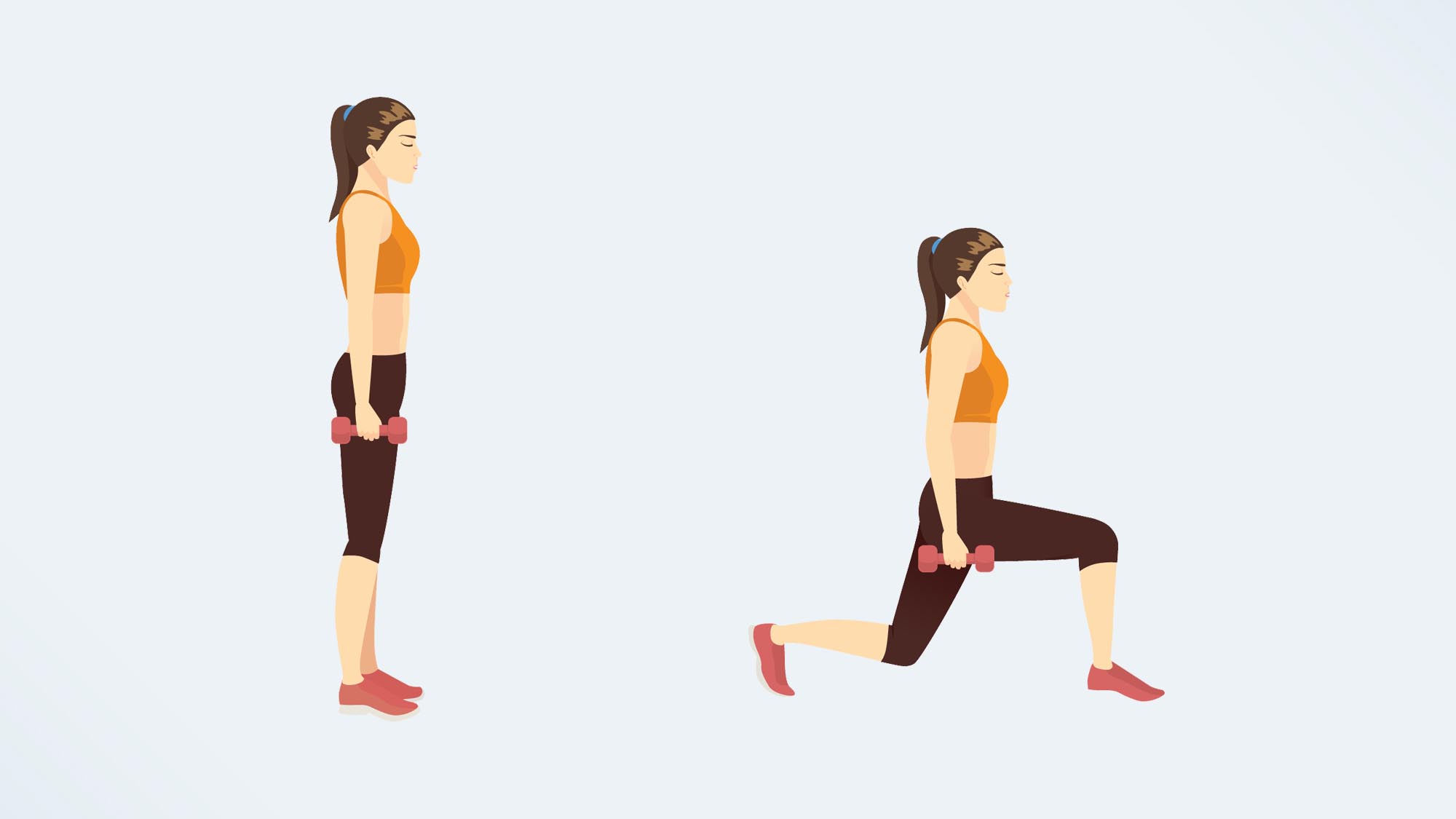
Another lunge variation, another chance to work the quads and glutes efficiently with a classic lower body strengthening exercise.
To perform the Walking lunge, stand with your feet about hip-width apart. Step your right foot out in front of you. Slowly bend the knees of both your front and back legs, making sure to keep your right knee over the middle of your right foot. Keep your core engaged and spine tall. Pressing your weight into the right foot, stand back up again and step your left foot in to meet the right. Step your left foot out in front of you and repeat the same motion. Complete 10-12 repetitions on each side, or until you reach muscle failure.
If you’re no stranger to the walking lunge, attempt this exercise without placing your back foot down after standing tall. Instead, step all the way through and place your back foot in front of you, and continue the lunge.
Add difficulty to the walking lunge by grabbing a pair of dumbbells.
9. Curtsey lunges
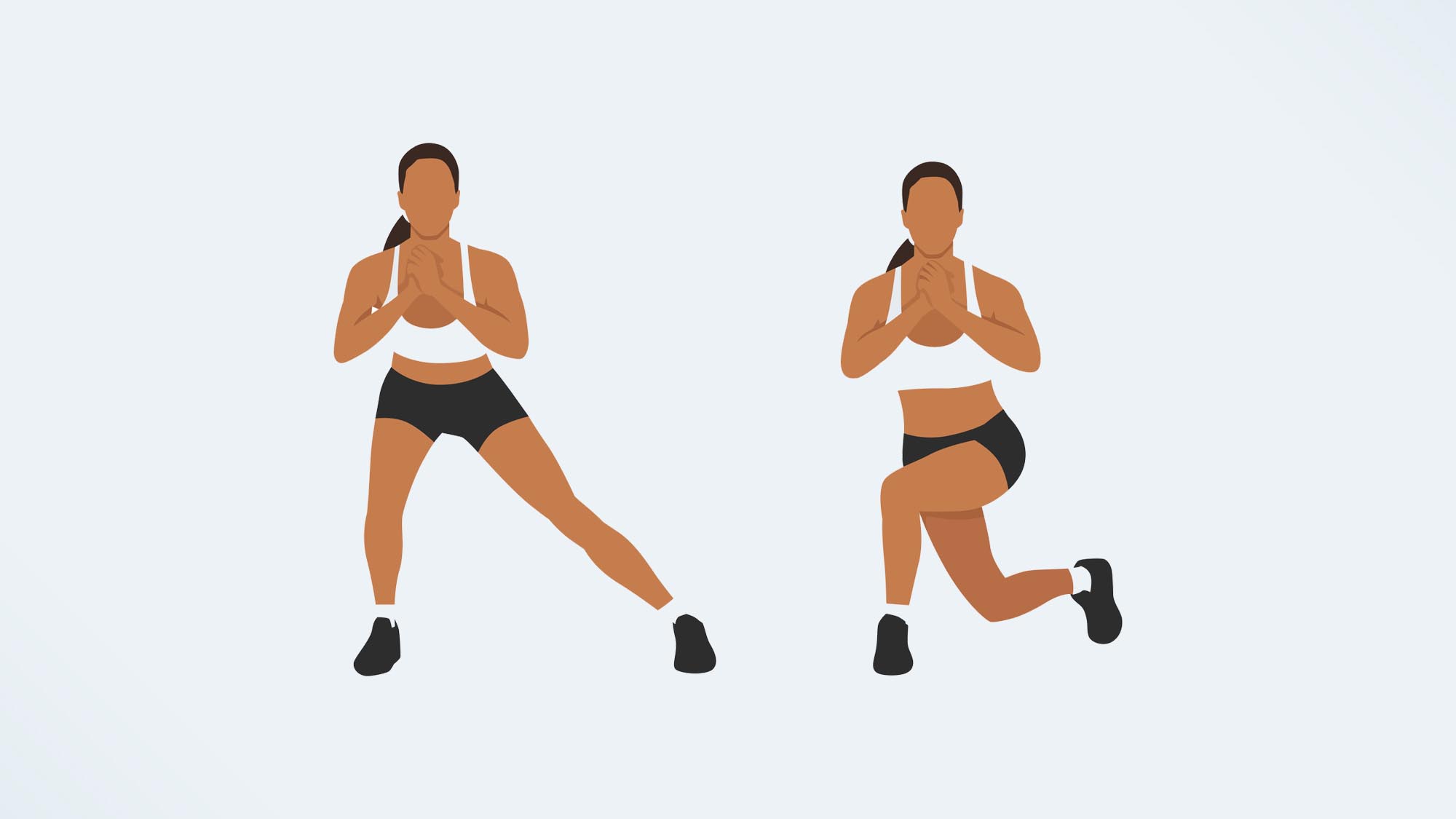
Our last lunge variation and final exercise, the Curtsey lunge is an optimal choice to develop not only glute and quad strength, but balance and stability as well.
To perform the Curtsey lunge, stand with your feet about shoulder-width apart. Keeping your hips square to the wall in front of you, step your right foot behind you and slightly to your left, lining up your right toes with the back of your left heel. Slowly lower yourself to the floor by bending both your knees, ensuring that your left knee stays in line with the middle of the left foot. Pressing your body weight into your left foot, step your right foot back to the starting position. Complete 10-12 repetitions or until muscle failure, then repeat on the other side.
A common beginner’s mistake is not stepping back wide enough, forcing the front knee to track beyond the front toes and the front heel to raise from the floor. Beginners will also often allow the front knee to fall too far to the side, not aligning with the middle of the foot. If you’re trying Curtsey lunges for the first time, pay close attention to your form to ensure correct muscle activation.
Pick up some dumbbells, kettlebells, or even a light barbell to increase the Curtsey lunge’s difficulty.
Looking for more workout inspiration? You only need a kettlebell and three moves to work your body in 25 minutes with this workout, plus, read how this fitness writer did 100 dumbbell chest presses a day for a week — and here's what happened.

Jennifer Rizzuto is a freelance writer and certified personal trainer based in Long Island, NY. She covers various fitness-related topics and reviews for Tom's Guide. She also writes sketch comedy and short films, and performs frequently as an actor, singer, and improviser. When she's not writing, working out, or performing, you'll find her trying to convince her husband to get a dog.
